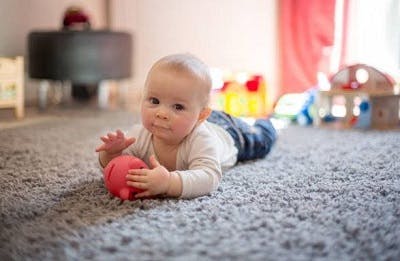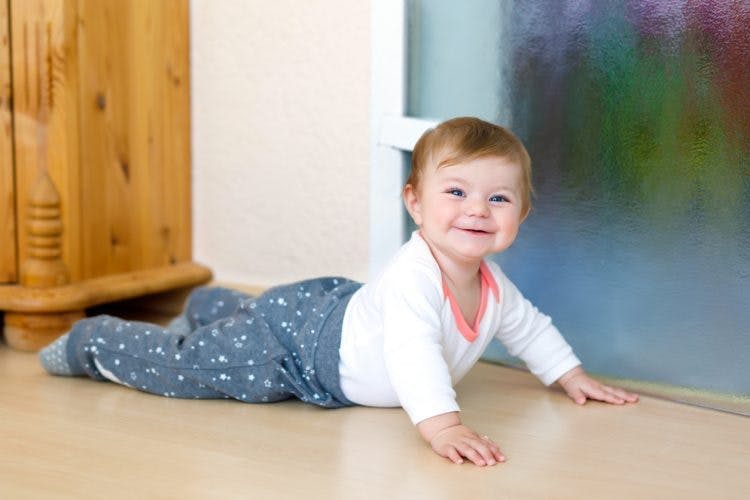Should you be concerned if your child with cerebral palsy is commando crawling?
Commando crawling is not your typical hands and knees crawling. As demonstrated in the video below, it’s characterized by the use of the arms to drag the body forward while the stomach and legs remain on the ground.
While it’s relatively common in infants, commando crawling might be a cause for concern amongst those with cerebral palsy. Parents of children with CP should be aware of what commando crawling might imply. For some, it is just a phase, but for others, it might be a sign of lower extremity impairment.
This article will explain why children with cerebral palsy commando crawl and when it becomes problematic.
Why Do Children with Cerebral Palsy Commando Crawl?
Cerebral palsy is a motor disorder that affects movement, balance, and coordination. Commando crawling is most commonly observed in children with spastic diplegia, a type of CP characterized by high muscle tone in the legs. This can cause stiff movements and make it difficult for children to control their lower extremity functions, resulting in developmental delays.
Alternatively, commando crawling may not be attributed to weakness in the legs, but rather a lack of core strength. Crawling is an activity that engages the entire body as it requires bilateral coordination of the arms and legs. Without sufficient strength in the core, children may struggle with tasks that require bilateral coordination and balance.
Now that you understand how cerebral palsy can cause commando crawling, let’s discuss its consequences.
Consequences of Prolonged Commando Crawling in Children with Cerebral Palsy
Even with cerebral palsy, many children who commando crawl learn to stand and walk, so it may not always be a cause for concern.
Commando crawling is problematic when it becomes a habit. Most infants learn to crawl between 6 to 10 months and transition out of it by 18 months. Prolonged commando crawling results in disuse of both the legs and core.
Our bodies are extremely adaptive and when you don’t use your muscles, they’ll weaken to conserve energy. Ultimately, weakened leg and core muscles will make it more challenging to phase out commando crawling.
Additionally, complications associated with cerebral palsy can cause further functional impairments. For example, most individuals with cerebral palsy experience spasticity (involuntary muscle contractions).
Severe spasticity can significantly restrict mobility, cause pain, and stunt growth. To prevent developmental complications, early intervention is essential.
In the following section, you’ll learn what you can do to correct your child’s commando crawling.
How to Correct Commando Crawling in Children with Cerebral Palsy

Early management will promote movements that can replace commando crawling before it becomes a habit.
Every individual experiences the effects of cerebral palsy differently, so a personalized approach to management is essential.
Below, we’ll discuss some management interventions that can help your child transition out of commando crawling
1. Consult with a Pediatric Physical Therapist
A pediatric physical therapist can identify weaknesses early and set realistic goals for improvement.
They’ll create a customized exercise plan to maximize your child’s mobility. The exercises may help:
- Stretch spastic muscles to maintain full range of motion
- Strengthen underused muscles to counteract spastic muscles
- Repetitively stimulate spastic muscles to reduce their hyperexcitability
Want 19 pages of CP recovery tips in PDF form? Click here to download our free illustrated ebook now (link opens a pop up for uninterrupted reading)
2. Wear Orthotic Devices
Your child’s body is constantly growing and unmanaged spasticity can negatively impact their development.
Wearing orthotic devices like braces or splints support normal musculoskeletal alignment, gently stretch spastic muscles, and combat progressive muscle tightening.
3. Focus on Repetitions
While the brain damage from cerebral palsy cannot be reversed, functional improvements are possible. Neuroplasticity is the brain’s ability to rewire itself and the most effective way to promote it is through repetitive movement.
Every movement your child makes sets off a unique set of neural pathways in their brain. Consistent stimulation helps the brain perceive a demand for that movement and promotes rewiring.
Ultimately, you want to encourage your child to move their legs as much as possible, often through creative play activities
Should You Be Worried About Commando Crawling?
If your child has just started commando crawling, just be vigilant at first. Many children with cerebral palsy commando crawl without ever transitioning onto their hands and knees. Instead, they’ll just start standing or walking.
However, if your child continues to commando crawl beyond the age of 18 months, you should consult with their pediatrician.
Hopefully, this article helped you better understand how cerebral palsy can affect commando crawling.











